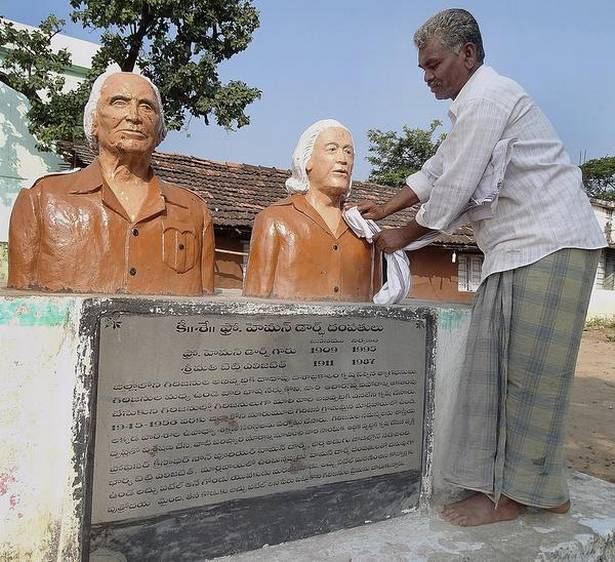Monthly Archives: May 2017
13
Ancient Gond wells yield water all year
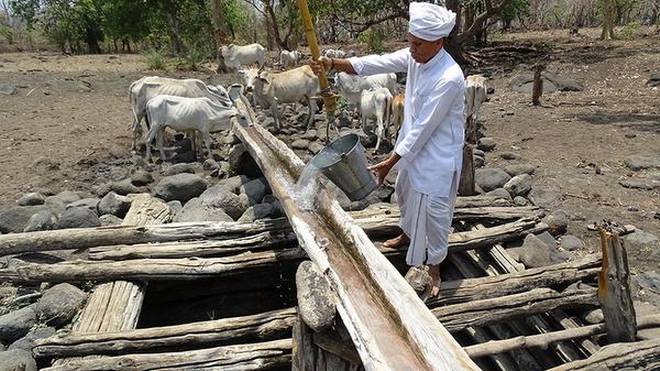
In arid Asifabad, a ‘kui’ dug over a century ago still fills the needs of the tribals of Kanchanpalli
The water shortage in what was undivided Adilabad district is of comparatively recent origin, if one looks at the evidence of a few surviving open wells, which are over a century old. It makes it clear that the residents of the area, mainly people of tribal origin, like the Raj Gonds, who live between the Penganga and the Godavari, had a close connect with natural resources.
These wells, known locally as ‘kui,’ yield water through the year, even in high altitude areas. One example is the well called kantam (perennially full), in Kanchanpalli village, in the Lingapur mandal of Kumram Bheem Asifabad district. It serves the needs of 80 families and over 100 heads of cattle. “It never dries up,” says Athram Bheem Rao, the 62-year-old inheritor of the Gond Raja title.
The sides of the rectangular kui are lined with teak logs, and at the top, thinner logs provide a secure place for the person drawing water to stand. A boom at the side, rather like those one would see at a railway crossing, lowers a pot or bucket attached to a rope into the well.
The water drawn is poured into a hollowed-out log, which pipes it into another hollow log. This collection method ensures that any silt that comes up settles at the bottom. After taking the water, the locals leave the lower log full for animals to drink.
The Gond people say that the water level in this well increases whenever there is rainfall in the catchment areas of the Kadem, a stream about 15 kilometres away. This indicates that an underground stream connects the two; the Gonds call this subterranean stream the Satganga.
Only a handful of such kuis still remain functional. One other can be found on the road between Chinna Dhoba and Seetagondi village, Sirpur mandal.
source: http://www.thehindu.com / The Hindu / Home> News> States> Telangana / by S Harpal Singh / Adilabad – May 08th, 2017
Adilabad remembers Samala Sadasiva
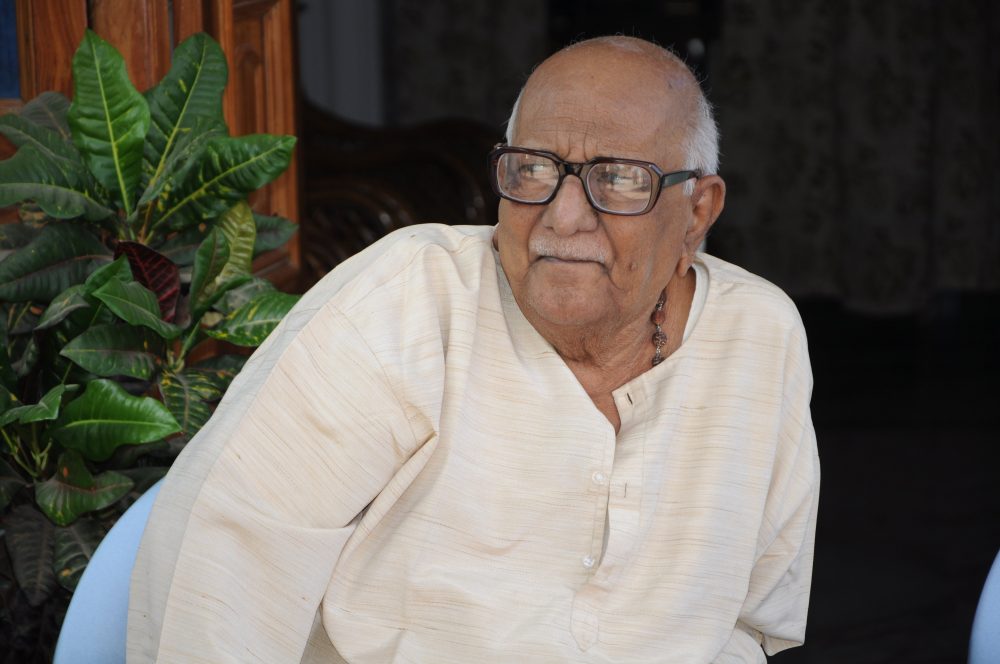
Adilabad:
Erstwhile Adilabad district, the heartland of Adivasis, has not only produced tribal legend Kumram Bheem, but eminent literary personalities. Kendra Sahitya Akademi award winner Samala Sadasiva, poet Vanamamalai Varadacharyulu of yesteryears, and poet and lyricist Guda Anjaiah are a few to name. Sadasiva’s 89th birth anniversary is celebrated on May 11.
A native of Tenugupalle in Dahegoan mandal of present Kumram Bheem Asifabad district, Sadasiva was a teacher by profession. He was born on May 11 in 1928. He passed away on August 7 in 2012. He had ventured into literature field in 1950 when he was barely 20. Also, he had excelled in music and translation. His work titled ‘Swara Layalu’, on Hindustani music, fetched him Sahitya Akademi award for the year 2011.
Dr Udari Narayana, a senior writer of Adilabad, told ‘Telangana Today’ that Sadasiva was a confluence of both literature and music. The octogenarian had rendered matchless services to the two fields for a period of over 60 years. He had introduced nuances of Marathi, Urdu and Persia for Telugu readers by recreating several classical texts of these languages.
“Sadasiva had meticulously studied both ancient and modern Telugu literature. He had produced extraordinary works in this language. He was an eminent critic, linguist and translator. His book Yaadi, on literature and literary personalities of Telangana, is a reference to writers and poets belonging to this region. He had inspired many to venture into the field of literature,” Narayana remarked.
Importantly, the multi-faceted writer had played a vital role in the inclusion of a lesson on Kumram Bheem in school textbooks in 1972. He was awarded honorary doctorates by Potti Sreeramulu Telugu University, Hyderabad and Kakatiya University, Warangal, for his unparallel contributions to Telugu language and literature. He was awarded Prathibha Rajiv Purashkaram by State government in 2005.
Some of creative works of this versatile teacher are Prabhatam (1949), Sambasiva Satakam (1950), Nireekshanam (1952), Viswamitram and Sakhinama, all of which are now collected in an anthology entitled Sadasiva Kavyasudha (2002), novels: Apashriti (1952), historiography — Urdu Sahitya Charitra (1963) and Parsi Kavula Prasakti (1975), biography — Mirza Ghalib (1969), translations: Amjad Rubayeelu (1963), Moulana Rumee Masnavi (1967), Kesava Sut (1970), Hindustani music: Malaya Marutalu (2001), Sangeeta Sikharalu (2006), and memoirs (Yaadi, 2005).
source: http://www.telanganatoday.com / Telangana Today / Home> Telangana> Adilabad / by Padala Santosh / May 10th, 2017
10
09
A tribute to Hyderabad braves
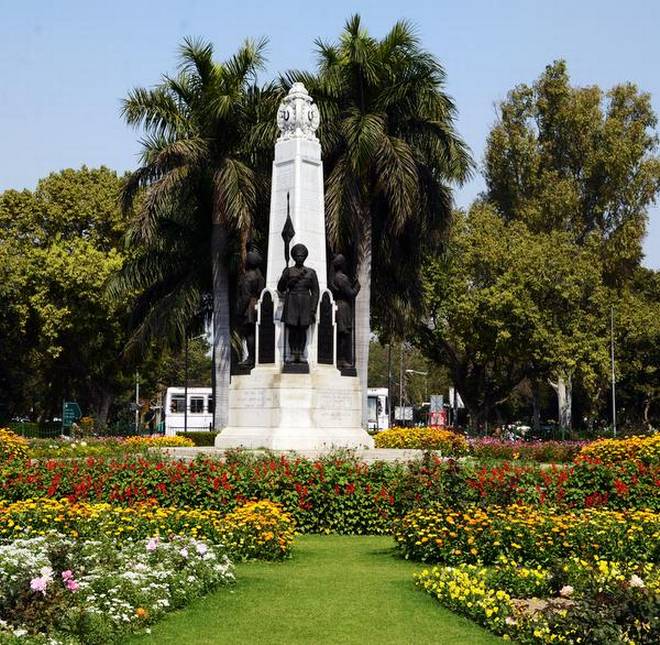
A relook at the legacy of the Teen Murti Memorial in Delhi which has a Hyderabad connect
The Teen Murti Memorial in New Delhi is set to be renamed again. What was Imperial Cavalry Brigade Memorial and became Teen Murti Memorial after Independence, is to be renamed Teen Murti Haifa Chowk timed with the first ever visit of an Indian Prime Minister to Israel. The tinkering with the name of a war memorial will not change the glorious memory and the gallantry of Indian soldiers.
Hyderabad House is a well known landmark in New Delhi and is a venue for the reception of foreign dignitaries. The Teen Murti memorial’s link to Hyderabad is less well known. But as the roundabout with three lancers wearing pugrees and khaki shorts grabs the nation’s attention due to yet another renaming row, it is time to remember the legacy of the memorial and its Hyderabad connect.
Just outside the Jamali Kunta darwaza of Golconda in Hyderabad is the area known as Second Lancers. Dotted with low squat houses painted white — some with extensions and some in the same state they were constructed — it has a few houses that still bear the names of the original allotees. While most of the men with Jamadar, Dafadar honorofics are no longer alive, the houses currently occupied by their children and grandchildren still carry their nameplates. These were some of the soldiers who saw action in France and later in Egypt and what was Palestine. The lancers from Hyderabad were the first to sail and were part of the 15th Imperial Service Cavalry Brigade along with lancers drawn from Jodhpur and Mysore princely states. The Teen Murti celebrates the bravery of soldiers from these three princely states.
To call them brave would be an understatement. The great war’s first mechanised weapon was the machine gun that shot out hundreds of bullets in an arc. The lancers from Hyderabad and the other princely states armed with just lances and light weapons were no match for the rat-rat-rat of the machine gun that mowed down anything that moved. But these men stood up, fought and won. One of the most impressive victory was at Haifa on September 23, 1918 and for this the residents of the city still celebrate Haifa Day organised by Indian embassy.
It was not easy to rouse Hyderabad soldiers to fight someone else’s war after crossing the sea. Before the war, the Nizam Osman Ali Khan had to issue a firman informing his soldiers that it is okay for them to fight against fellow Muslims of the Ottoman empire. The port city of Haifa was the key entrepot for the Allied war machine. Years later, the British withdrew from the city leaving the Jews and Arabs to fight it out. The Jews, using a three-pronged attack, captured the city on April 24 in 1948 as the Arabs left their ancient homeland.
Interestingly, while the Teen Murti memorial is in the news, the actual war memorial built for the soldiers who fought for the British in the first World War remains neglected and unseen amidst bushes and brambles in the cantonment area near Second Lancers area in Hyderabad.
Memorable designs
Teen Murti House in New Delhi was designed by Edwin Lutyens, while the Teen Murti Memorial was designed by Leonard Jennings. The one accessible war memorial in Hyderabad, the EME War Memorial in Secunderabad,was designed by Eric Marrett.
source: http://www.thehindu.com / The Hindu / Home> Features> Metroplus / by Serish Nanisetti / May 08th, 2017
Haimendorf’s hilltop haven in Adilabad
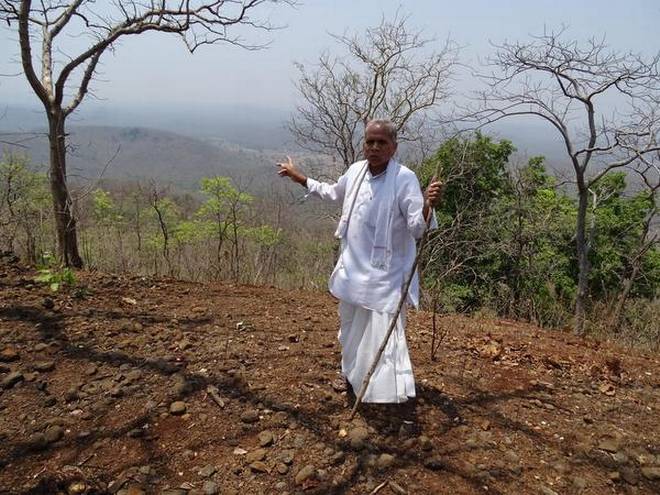
Pirengan Patar, a plateau in Telangana, keeps alive the memory of a legendary ethnographer.
Every now and then, Atram Bheem Rao, inheritor of the Gond Raja of Kanchanpalli title, remembers Christoph von Fürer-Haimendorf and his contributions to improving the lives of the Raj Gond and other Adivasi tribes of the Adilabad region. When he does, he visits a 250-metre high hill near his village, atop which is a small platform made of stones, to pay his respects to the memory of the legendary Austrian ethnographer.
Prof. Haimendorf started his work in India in what is now Nagaland. During World War II, as a citizen of the Third Reich, he was detained by the British in India. He was confined to what was then Hyderabad state, but was later allowed to live among the tribal peoples of present-day Telangana and do fieldwork.
A deep connection
In 1942, Prof. Haimendorf and his wife Betty Barnado, also a noted ethnographer, first came to Kanchanpalli, in Sirpur mandal, seeking help from Mr. Rao’s grandfather — who was also named Bheem Rao — for their work. The local people could not pronounce the Austrian’s name, Mr. Rao says, so they called him ‘Pirengan,’ which is derived from the Hindustani firangi, foreigner.
At the end of the war, the Nizam’s government appointed Prof. Haimendorf Advisor for Tribes and Backward Classes. During his tenure, he set up educational and other schemes for tribal peoples and taught at Osmania University.
The professor and his wife did path-breaking work in the Northeast, and in Nepal, where he was the first foreigner to document indigenous cultures. He also taught at the School of Oriental and African Studies in London. Through all this, over forty years, the couple often came back to the Adilabad area to do more research.
“The Haimendorfs avoided this place during summer, but used to come here frequently during winters all through the late 1970s until their death,” Mr. Rao says. “They had an elevated platform made, for them to relax in the winter sun and take in nature’s spread from the hilltop.” From this vantage point, one can see the Godavari flowing in the distance, and the villages in the valley below.
The plateau is known locally as Pirengan Patar, in their honour. Mr. Rao told The Hindu that the platform would have been destroyed had the government gone ahead with its plan to build a wireless repeater station on it in the 1990s. But the fear of Naxalites damaging it had led to a change of plan.
source: http://www.thehindu.com / The Hindu / Home> News> States> Telangana / by S. Harpal Sigh / Kanchanpalli – May 05th, 2017
Venkaiah, Bandaru give away HMTV Business Excellence Awards
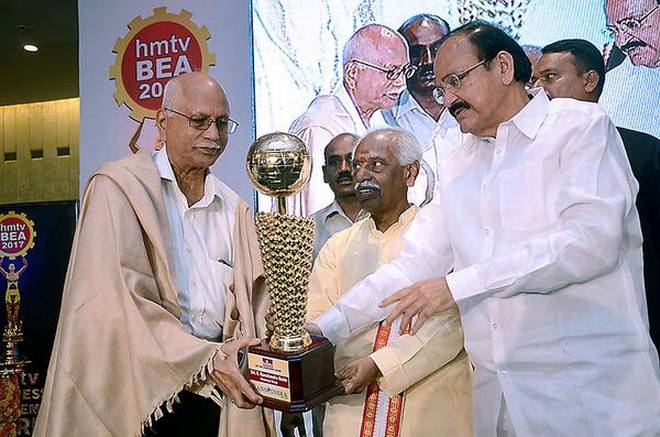
NTPC Ramagundam, KIMS Hospital get awards
Recognising the contribution of several business leaders and entrepreneurs, who made their mark in various sectors from the two Telugu States, the Hyderabad Media House Ltd. running HMTV news channel presented Business Excellence Awards- 2017 here on Saturday.
The awards instituted for the first time this year which would become an annual feature hereafter were given away by Union Ministers M. Venkaiah Naidu and Bandaru Dattatreya.
The event saw two distinguished businessmen – J. Rameshwar Rao, prominent builder and infrastructure developer and G. Ramachandra Naidu of Amararaja Group – being honoured with Lifetime Achievement Award.
A seven-member jury comprising Ramesh Loganathan, professor-IIIT, and representatives from CII, FTAPCCI, HYSEA, CREDAI and IT companies went through hundreds of nominations and chose the best nominees in 14 sectors. They also presented special jury awards.
Mr. Venkaiah Naidu said recognising the achievements of businessmen and industrialists and felicitating them was a noble deed as it would serve as an inspiration to several others. The industrialists and businessmen were wealth creators, but in our country they were often viewed with suspicion.
Prime Minister Narendra Modi extended a red carpet welcome to investors who run their business with good values. The government had no business to be in business but focus on providing basic amenities and infrastructure to people and the Vajpayee government had laid that foundation, he said.
The Indian economy was the only one that was growing at a healthy rate, thanks to the dynamism of Prime Minister Modi. Though some people criticised demonetisation, it brought money back into banks with an accountability.
Labour Minister Dattatreya said the government wanted to create a conducive atmosphere for growth of industry and labour for employment generation and poverty alleviation.
NTPC Ramagundam, KIMS hospital, got awards in separate categories. Vaman Rao, Chairman of Kapil Group that set up HMTV, and government officials were present.
source: http://www.thehindu.com / The Hindu / Home> News> Cities> Hyderabad / by Special Correspondent / Hyderabad – May 06th, 2017
Moving to Hyderabad got me out of the shadow of Raja and Radha Reddy
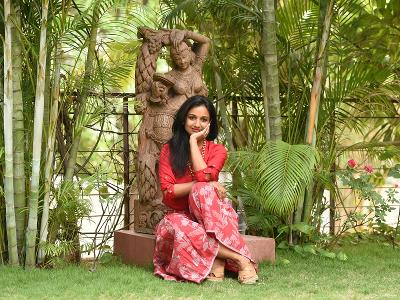
She may be the daughter of the Kuchipudi greats Raja and Radha Reddy, but over the years, she has proved to be more than just that. Yamini Reddy has carved a niche not only as a performer, but also as an able guru having honed many young dancers since the time she moved to Hyderabad — a decade ago.
It was marriage that got her out of Delhi, where her parents live. And today, when she sits down to reminisce, that shift seems to have been just what she needed to grow as an individual. “When I look back today, I am glad I got out of Delhi. It came as an opportunity to move out of my parents’ shadows and do something on my own. I feel, in Delhi I would have always been under the shadow of Raja-Radha Reddy,” says the 35-year-old dancer as she settles down for a chat with Hyderabad Times about her childhood in Delhi, growing up with two mothers (Raja Reddy is married to Radha and Kausalya), sibling rivalry with her dancer-musician sister Bhavana, marriage, motherhood and more.
Excerpts:
For the rest of the world, Raja-Radha Reddy are legends. At home, they were parents
While growing up in Delhi, it didn’t really occur to me that my parents are these great Kuchipudi exponents whom everybody looks up to. They were performers, who travelled the world to popularise Kuchipudi. Their days began and ended with dance… I vividly remember, there were days when they would forget to pick me up from school (laughs). I’d wait and eventually my patience would run out and I would go to the school’s office to call home. I’d say, ‘Dad, you forgot to pick me up again’, and then he would hurriedly assure, ‘No no, I am coming, I am coming.’
They also went on long foreign tours; sometimes for two to three months at a stretch. So by the time I was in 4th or 5th grade, I was pretty independent. I learned to be responsible from an early age.
Only after I handed my mom my MBA did she let me pursue dance as a profession
I was always passionate about dance even when I was a toddler. But when I told my parents that I want to take up dance professionally, they flatly said, ‘No’.
It was my mother who put her foot down. She said, ‘You have to study. We don’t want you to pursue dance solely as it’s a long and hard struggle. We have been through it…’
I realised that my mom wanted me to finish my education. So to please her, I did my BCom from Lady Shri Ram College before doing MBA and went to her with the certificate. She said, ‘Good, now look for a job’. That was when I insisted that I want to dance.
My dad wouldn’t allow me to do a rangapravesham till I was 20
My dad is a very loving and doting father. But as a guru, discipline was his priority.
He wouldn’t let me do my rangapravesham till I was 20. ‘You are not ready’ is all he would tell me. It was in 2002, when I was prepping for my rangapravesham that I saw how he grilled his disciples. I used to hear such awful things from my father that it sometimes used to bring me to tears.
All issues we had in the classroom were rarely left behind there; they used to spill over to the dinner table. We carried them home, and we bickered over dinner. Sometimes, dinner would go on for two hours. And our house helps would sit and wait for us to finish, so that they can clean up and go home.
Two mothers meant double the love and double the discipline
Of course, we faced a lot of strange questions from our peers at school or college about us having two mothers. They would ask us questions like, ‘So all of you live under one roof?’ But, for us, it seemed all so natural. We were one unit as a family and there was no differentiation between the children either.
But growing up with two mothers means double the love and double the criticism. If you do something wrong, you’ll have to hear about it four times, instead of two times. But amma and Kausalya mummy have completely different world views. So, that kind of made things interesting. And dad was always a refuge. When both moms were after us, we ran to him (laughs).
I was an awkward teen
I was this awkward teenager, a plump tomboy, who walked with a hunch. If you had seen me back then, you wouldn’t believe that I was training to be a dancer (laughs). But I was blind to all these things — I saw only dance. So, I put in a lot of conscious effort to get to where I am today, from losing weight to correcting my posture. Bhavana, on the other hand, was one of those children who is extremely talented. She was also dainty, pretty and feminine.
Dance came naturally to me. music was Bhavana’s forte
Both of us had to learn dance and music. But between me and Bhavana, she was a natural with music. She started singing at a very young age and went on to learn the violin too. I struggled with singing. And it was very annoying to be in the same class as your sister, who was eight-years younger, acing it. When teacher would say ‘Paadandamma padandi’, Bhavana would effortlessly go ‘Saregamapadanisa’ and I went ‘Saaaaa, reeee, gg-gggaa’.
But today, as artistes we are very different. Someone aptly said, ‘Ek drupad hai, aur dusri thumri hai’. So there is really no competition between us.
Marriage brought me to Hyderabad
I got married and I landed in Habsiguda in 2006. It was a drastic change for me. The first few months, I just stayed at home and practised dance. My husband (Srinivas) and his cousins were great when it came to introducing me to the city. But I still remember the first few months being a bit lonely and very silent. It was in 2007, when I started my classes, that I found a new lease of life… a purpose in teaching Kuchipudi.
Motherhood changed me as a dancer
Motherhood is this great responsibility that is thrust on you. When I got married, I used to wake up late, which was a shock for a family of early raisers. I would wake up at 9 am and come down rubbing my eyes to hear husband’s jokes, like: ‘My morning is Yamini’s midnight’
After motherhood, you have no excuse or choice. You have to wake up early and get cracking. The realisation that there is a life that relies on you opens up new dimensions that you did not know existed. You don’t know how much you can stretch yourself till motherhood hits you. When I look back now, I find it funny that I would get anxious for not having my 8-hours of sleep before a show. Now, I’ve the capacity to have a 30-hour day (laughs). Motherhood also changed me as a dancer. My experiences as a mother reflect in how I interpret subjects now.
source: http://www.timesofindia.indiatimes.com / The Times of India / News> City News> Hyderabad News / by Samyuktha K / May 03rd, 2017
